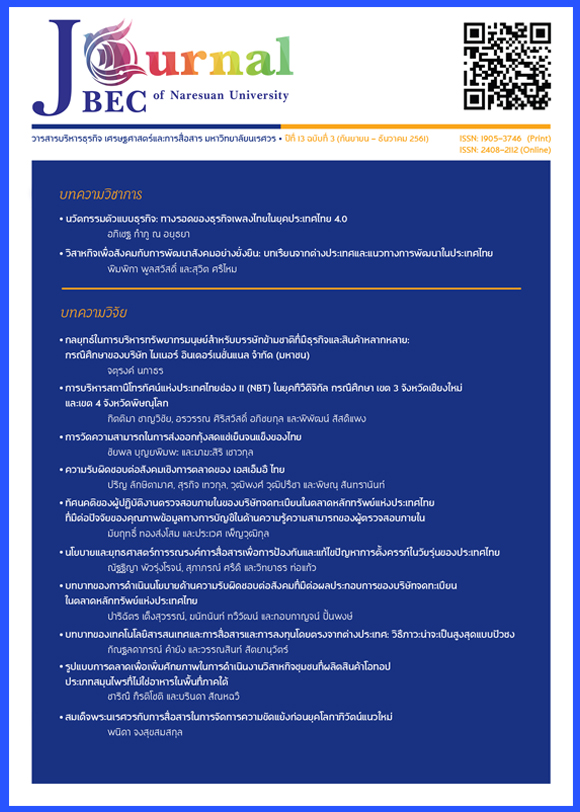ความรับผิดชอบต่อสังคมเชิงการตลาดของ เอสเอ็มอี ไทย
Main Article Content
บทคัดย่อ
การวิจัยครั้งนี้มีวัตถุประสงค์เพื่อศึกษาความรับผิดชอบต่อสังคมเชิงการตลาดของผู้ประกอบการเอสเอ็มอีไทย โดยใช้เทคนิคการวิเคราะห์แบบจำลองเส้นทางด้วยวิธีกำลังสองน้อยที่สุดบางส่วน ผลการวิจัยพบว่าความรับผิดชอบต่อสังคมเชิงการตลาดของผู้ประกอบการเอสเอ็มอีไทยในมิติผู้บริโภค ประกอบด้วย 17 ตัวชี้วัดจาก 2 องค์ประกอบ ได้แก่ องค์ประกอบที่ 1 ประเด็นด้านผู้บริโภคข้อมูลที่เป็นจริงและไม่เบี่ยงเบนการปฏิบัติทางสัญญาที่เป็นธรรม การคุ้มครองด้านสุขภาพและความปลอดภัยของผู้บริโภค การบริโภคเพื่อสนับสนุนให้เกิดการบริโภคอย่างยั่งยืนจำนวน 10 ตัวชี้วัด และองค์ประกอบที่ 2 สิทธิคุ้มครองผู้บริโภค มีการจัดตั้งองค์กรคุ้มครองผู้บริโภคทำหน้าที่เผยแพร่ข้อมูลข่าวสารความรู้ ตลอดจนกระตุ้นเตือนผู้บริโภคให้ตระหนักถึงอันตรายที่มาจากการบริโภคสินค้าหรือบริการที่ไม่ได้มาตรฐานจำนวน 7 ตัวชี้วัด โดยในแต่ละองค์ประกอบต่างมีความตรงเชิงเสมือน ทั้งนี้เนื่องจากค่าความเชื่อมั่นเชิงโครงสร้างอยู่ระหว่าง 0.811 ถึง 0.853 ซึ่งผ่านเกณฑ์มาตรฐานมากกว่า 0.60 และค่าน้ำหนักองค์ประกอบอยู่ระหว่าง 0.408 ถึง 0.733 ซึ่งมีค่าตั้งแต่ 0.40 ขึ้นไป (ค่าสัมบูรณ์)
Article Details
References
2. Cronbach, L. J. (2003). Essential of psychology testing. New York: Hanpercollishes.
3. Department of Industrial Works. (2014). Guidelines for industrial entrepreneurs practices as standard measurement as CSR. Bangkok: Amarin Printing and Publishing.
4. Department of Industrial Works. (2015). Standard for corporate social responsibility. Bangkok: Amarin Printing and Publishing.
5. Department of Industrial Works. (2016). Cumulative number of factories allowed to operateunder the factory act 1992. Retrieved January 28, 2017, from https://www.diw.go.th/hawk/content.php?mode=spss59
6. Esteghamati, A., Zandieh, A., Khalilzadeh, O., Meysamie, A. and Ashraf, H. (2010). Clustering of metabolic syndrome components in a Middle Eastern diabetic and non-diabetic population. Diabetology and Metabolic Syndrome, 2(1), 36-43.
7. Green, T. and Peloza, J. (2011). How does corporate social responsibility createvalue for consumers. Journal of Consumer Marketing, 28(1), 48-56.
8. Hair, J. F., Anderson, R. E., Tatham, R. L. and Black, W. C. (2010). Multivariate data analysis. New Jersey: Prentice-Hall.
9. Hassan, L., Shaw, D., Shiu, E., Walsh, G. and Parry, S. (2013). Uncertainty in ethical consumer choice: A conceptual model. Journal of Consumer Behavior, 12(3), 182-193.
10. Hatcher, L. (1994). A step-by-step approach to using the SAS system for factor analysis and structural equation modeling. NC: SAS Institute.
11. Kim, Y. and Kim, S. Y. (2010). The influence of cultural values on perceptions of corporate social responsibility: Application of Hofstede’s dimensions to Korean public relations practitioners. Journal of Business Ethics, 91(4), 485-500.
12. Kultakormseat, N., Laksitamas, P. and Na Pathum, S. (2015). The structural equation model of causal factors influencing marketing strategies for fashion business of Thai garment towards the ASEAN economic community market. Journal of Business, Economics and Communications, 10(2), 145-156.
13. Martin, N. (2008). Development of a satisfaction survey analyzer using Partial Least Square Path Modeling (PLS-PM). Philosophy and Phenomenological Research, 76(3), 674-681.
14. Moosmayer, D. C. and Fuljahn, A. (2010). Consumer perceptions of cause relatedmarketing campaigns. Journal of Consumer Marketing, 27(6), 543-549.
15. Nonthanatorn, P. (2010). Corporate social responsibility management. Nonthaburi: Think Beyond Book.
16. Office of The Consumer Protection Board. (2015). Consumer information. Retrieved January 28, 2017, from https://www.ocpb.go.th/ewt_news.php?nid=36
17. Parina, P. And Matt, O. (2009). Research report on CSR development in Thailand and the volunteer role (translated). Bangkok: The Network for Sustainable Development Association.
18. Perez, A., Salmones, M. M. G. and Del Bosque, I. R. (2013). The effect of corporateassociations on consumer behavior. European Journal of Marketing, 47(1/2), 218-238.
19. Piriyakul, M. (27-28 May 2010). Partial Least Square path modeling (PLS Path Modeling). in Proceeding The 11th Statistics and Applied Statistics Conference (pp. 1-23). Holiday Inn Chiang Mai: Faculty of Science, Chiang Mai University.
2. Rodrigues, P. and Borges, A. P. (2015). Corporate social responsibility and its impact in consumer decision-making. Social ResponsibilityJournal, 11(4), 690-701.
21. Rovinelli, R. J. and Hambleton, R. K. (1977). On the use of content specialists in the assessment of criterion-referenced test item validity. Dutch Journal for Educational Research, 2(2), 49-60.
22. Social Business Institute. (2009). CSR definition. Retrieved January 27, 2017, from https://www.csri.or.th/knowledge/csr/193
23. Suwannawong, S. (2010). Introduction to statistics for the questionnaire. Retrieved January 24, 2017, from https://ruchareka.wordpress.com/2010/05/15/
24. Thailand Institute of Scientific and Technological Research. (2009). Social responsibility and ISO 26000 corporate social responsibility standard. Retrieved January 30, 2017, from https://www.tistr.or.th/tistr/csr/file/CSR2552.pdf
25. Thanomsiang, N. (2007). The quality of questionnaire. Khon Kaen: Statistics and demography department Khon Kaen University.
26. Thomson, S. K. (1992). Sampling. New York: John Wiley and Sons.
27. Tirakanan, S. (2007). Research methodology for social science: Implementation guide. Bangkok: Chulalongkorn University Printing.
28. Viratchai, N. (1999). The linear relationship (LISREL): Statistic for social science and behavioral sciences. Bangkok: Chulalongkorn University Printing.
29. Yammeesri, J. and Herath, S. K. (2010). Board characteristics and corporate value: Evidence from Thailand. Corporate Governance: The International Journal of Business in Society, 10(3), 279-292.

